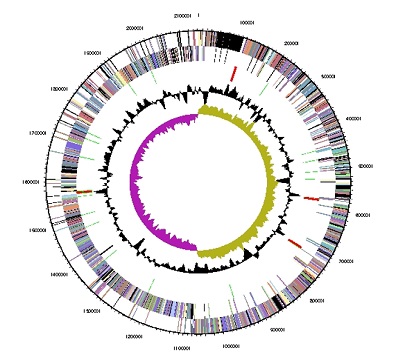User:S4355889: Difference between revisions
| Line 15: | Line 15: | ||
==Description and significance== | ==Description and significance== | ||
Named after french biologist Adrien Veillon who first discovered the species in 1898 '''[bacterio.net/veillonella.html and 1st ref of genome paper]''', ''Veillonella parvula'' is a gram negative bacteria is found in many of the microenvironments of the human body, but is most common and well described in the oral cavity and the gastrointestinal tract '''[REF]'''. It comes from the ''Negativicutes'' class which has a | Named after french biologist Adrien Veillon who first discovered the species in 1898 '''[bacterio.net/veillonella.html and 1st ref of genome paper]''', ''Veillonella parvula'' is a gram negative bacteria is found in many of the microenvironments of the human body, but is most common and well described in the oral cavity and the gastrointestinal tract '''[REF]'''. It comes from the ''Negativicutes'' class which has a perculiar gram negative cell wall despite being a part of the ''Firmicutes'' phyla, in which the majority of species are gram positive. ''V. parvula'' is anaerobic, auxotrophic, lactate fermenting and cocci shaped '''[KEGG, genome paper and other REFs]'''. The species is small at 0.3-0.5um '''[REF from genome paper]'''. | ||
''Veillonella parvula'' is known for its close association with ''Streptococcus'' species (in particular ''S.sanguinus'')'''[REF]'''. As ''V. parvula'' ferments lactate, a common byproduct of anaerobic respiration in bacteria, it has a commensual relationship with ''Streptococcus spp.'' where it will bind to the surface of | ''Veillonella parvula'' is known for its close association with ''Streptococcus'' species (in particular ''S.sanguinus'')'''[REF]'''. As ''V. parvula'' ferments lactate, a common byproduct of anaerobic respiration in bacteria, it has a commensual relationship with ''Streptococcus spp.'' where it will bind to the surface of the cells and metabolise the lactate as it is produced. This benefits ''V. parvula'' as it does not have to compete for resources. Coaggregation of ''Veillonella spp.'' with certain ''Streptococcus spp.'' (each species has preferences) is also shown to promote biofilm formation '''[Veil+strep=biofilmREF]''' and the two species are known early colonisers in oral plaque communities '''[REF]'''. | ||
Give a general description of the species (e.g. where/when was it first discovered, where is it commonly found, has it been cultured, functional role, type of bacterium [Gram+/-], morphology, etc.) and explain why it is important to study this microorganism. Examples of citations <sup>[[#References|[1]]]</sup>, <sup>[[#References|[2]]]</sup> | Give a general description of the species (e.g. where/when was it first discovered, where is it commonly found, has it been cultured, functional role, type of bacterium [Gram+/-], morphology, etc.) and explain why it is important to study this microorganism. Examples of citations <sup>[[#References|[1]]]</sup>, <sup>[[#References|[2]]]</sup> | ||
Revision as of 11:29, 5 September 2016
Name: Callum Le Lay
Bench ID: C
Date: 31/08/2016
[1]
Classification
Higher order taxa
Bacteria - Terrabacteria group - Firmicutes - Negativicutes - Veillonellales - Veillonellaceae - Veillonella
Species
Type strain: Prevot Te 3 = ATCC 10790 = DSM 2008 = JCM 12972
Species name and type strain (consult LPSN http://www.bacterio.net/index.html for this information)
Description and significance
Named after french biologist Adrien Veillon who first discovered the species in 1898 [bacterio.net/veillonella.html and 1st ref of genome paper], Veillonella parvula is a gram negative bacteria is found in many of the microenvironments of the human body, but is most common and well described in the oral cavity and the gastrointestinal tract [REF]. It comes from the Negativicutes class which has a perculiar gram negative cell wall despite being a part of the Firmicutes phyla, in which the majority of species are gram positive. V. parvula is anaerobic, auxotrophic, lactate fermenting and cocci shaped [KEGG, genome paper and other REFs]. The species is small at 0.3-0.5um [REF from genome paper].
Veillonella parvula is known for its close association with Streptococcus species (in particular S.sanguinus)[REF]. As V. parvula ferments lactate, a common byproduct of anaerobic respiration in bacteria, it has a commensual relationship with Streptococcus spp. where it will bind to the surface of the cells and metabolise the lactate as it is produced. This benefits V. parvula as it does not have to compete for resources. Coaggregation of Veillonella spp. with certain Streptococcus spp. (each species has preferences) is also shown to promote biofilm formation [Veil+strep=biofilmREF] and the two species are known early colonisers in oral plaque communities [REF].
Give a general description of the species (e.g. where/when was it first discovered, where is it commonly found, has it been cultured, functional role, type of bacterium [Gram+/-], morphology, etc.) and explain why it is important to study this microorganism. Examples of citations [1], [2]
Genome structure
Select a strain for which genome information (e.g. size, plasmids, distinct genes, etc.) is available.
Cell structure and metabolism
Cell wall, biofilm formation, motility, metabolic functions.
Ecology
Aerobe/anaerobe, habitat (location in the oral cavity, potential other environments) and microbe/host interactions.
Pathology
Do these microorganisms cause disease in the oral cavity or elsewhere?
- Periodontitis and dental caries
- Bacterial vaginosis
- Osteomyelitus
- Endocarditis
Application to biotechnology
Bioengineering, biotechnologically relevant enzyme/compound production, drug targets,…
Current research
Summarise some of the most recent discoveries regarding this species.
References
References examples
- ↑ MICR3004
Notes
TEMPORARY: TO BE DELETED AFTER FINISH
This page was written by Callum Le Lay for the MICR3004 course, Semester 2, 2016

